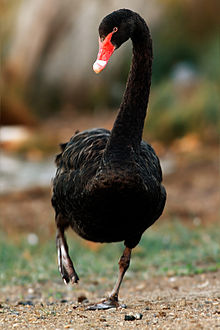|
 The black swan is New Zealand’s largest wetland bird, around 1.2 metres long and weighing 5-6 kilograms. Breeding begins at 2-4 years old and, while they do not mate for life, a mating pair may stay together for more than one breeding season. It has been estimated that in large colonies only about 25% of the population breed in any one year. Breeding occurs between July and September. If food is abundant, a pair may nest again in summer. (This has been seen in the lower lake at Whitby.) On average 6 eggs are laid. Cygnets hatch in 4-6 weeks and fledge in about 4 months, though the family may remain together for several months longer. Eggs and young cygnets are vulnerable to predators, especially rats and black-backed gulls. Total lifespan can be up to 30 years. The black swan is New Zealand’s largest wetland bird, around 1.2 metres long and weighing 5-6 kilograms. Breeding begins at 2-4 years old and, while they do not mate for life, a mating pair may stay together for more than one breeding season. It has been estimated that in large colonies only about 25% of the population breed in any one year. Breeding occurs between July and September. If food is abundant, a pair may nest again in summer. (This has been seen in the lower lake at Whitby.) On average 6 eggs are laid. Cygnets hatch in 4-6 weeks and fledge in about 4 months, though the family may remain together for several months longer. Eggs and young cygnets are vulnerable to predators, especially rats and black-backed gulls. Total lifespan can be up to 30 years.
Black swans are herbivorous, feeding mainly on submerged vegetation. In Pāuatahanui Inlet they feed almost exclusively on sea grass, preferring to crop sub-tidal and intertidal areas when low tide is cycling between mid-ebb and mid-flow. Using their long neck to advantage they eat both leaves and rhizomes.
Recent research in Golden Bay and Tauranga Harbour shows that swans can have a significant impact on the physical sea floor environment and on biodiversity. Cropping of sea grass leaves directly impacts the food chain by diminishing the food source of herbivorous fish while reducing the surface area for growth of minute algae and fungi that are food to small crustaceans and juvenile fish – the base of the food chain for larger carnivorous fish.
Potentially more serious is the effect of grubbing up rhizomes on local biodiversity. This denudes the sediment making it less suitable for several invertebrate species. In Tauranga Harbour swans frequently create barren patches of sand equivalent to a circle of 30 cm diameter. Because full recovery can take up to three years persistent overgrazing must severely degrade sea grass meadows and have a permanent adverse effect on biodiversity of the area. Further research is needed to assess the impact of grazing swans on sea grass viability in our Inlet.
Finally black swans are not very efficient feeders. A Golden Bay survey estimated food intake at around half a kg/swan/day but, with only about 14% assimilated, most is ejected as faeces. This wasteful feeding regime has an upside, releasing large quantities of finely broken down plant material into the environment to be consumed by other bottom dwelling species, e.g. cockles. However, a potential adverse factor is the impact of swan faecal material (high in nitrogen and phosphorus) on nutrient levels in the Inlet. This can affect water quality and clarity (a process known as eutrophication), impeding photosynthesis by sea grass and algae. For Pāuatahanui Inlet it is not known how significant the swans’ contribution to nutrient levels is compared with rural and urban runoff.
Photo of black swan: unknown photographer.
|